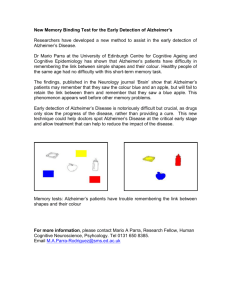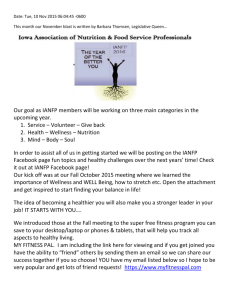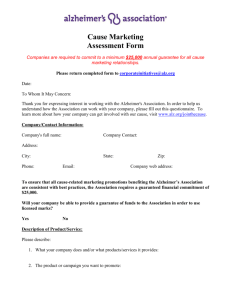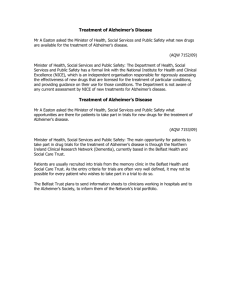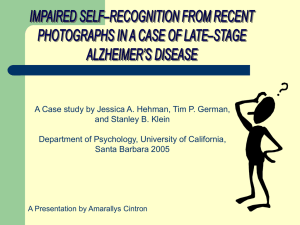PURSUIT A World Without Alzheimer’s? A monthly wellness newsletter from Better You
advertisement
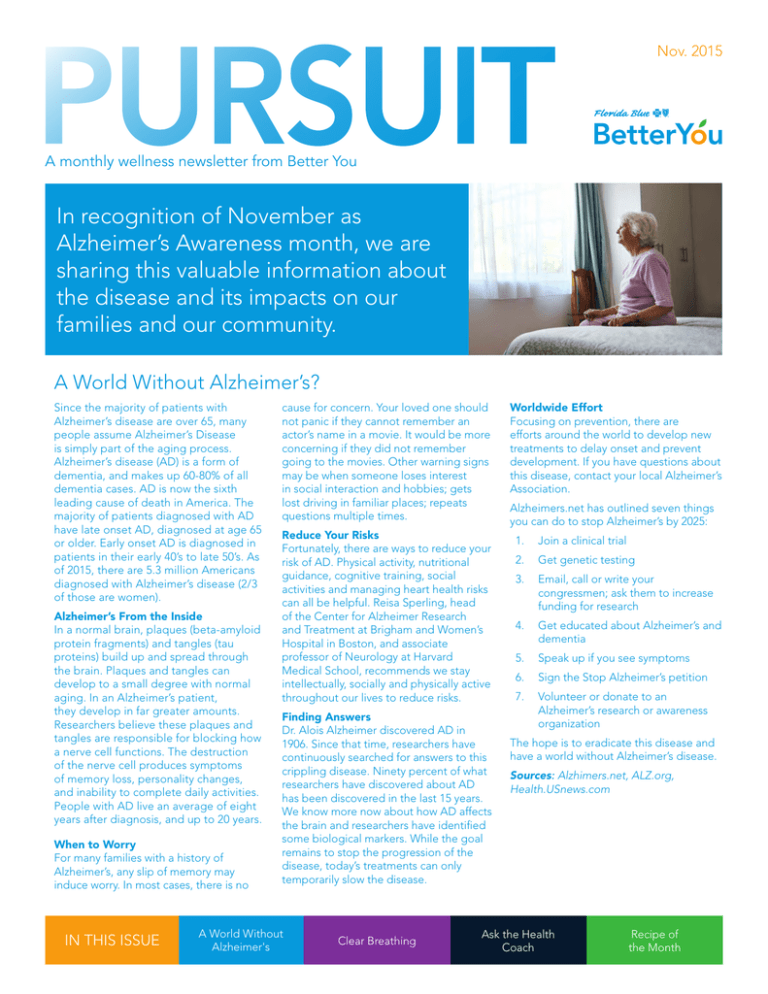
PURSUIT Nov. 2015 A monthly wellness newsletter from Better You In recognition of November as Alzheimer’s Awareness month, we are sharing this valuable information about the disease and its impacts on our families and our community. A World Without Alzheimer’s? Since the majority of patients with Alzheimer’s disease are over 65, many people assume Alzheimer’s Disease is simply part of the aging process. Alzheimer’s disease (AD) is a form of dementia, and makes up 60-80% of all dementia cases. AD is now the sixth leading cause of death in America. The majority of patients diagnosed with AD have late onset AD, diagnosed at age 65 or older. Early onset AD is diagnosed in patients in their early 40’s to late 50’s. As of 2015, there are 5.3 million Americans diagnosed with Alzheimer’s disease (2/3 of those are women). Alzheimer’s From the Inside In a normal brain, plaques (beta-amyloid protein fragments) and tangles (tau proteins) build up and spread through the brain. Plaques and tangles can develop to a small degree with normal aging. In an Alzheimer’s patient, they develop in far greater amounts. Researchers believe these plaques and tangles are responsible for blocking how a nerve cell functions. The destruction of the nerve cell produces symptoms of memory loss, personality changes, and inability to complete daily activities. People with AD live an average of eight years after diagnosis, and up to 20 years. When to Worry For many families with a history of Alzheimer’s, any slip of memory may induce worry. In most cases, there is no IN THIS ISSUE cause for concern. Your loved one should not panic if they cannot remember an actor’s name in a movie. It would be more concerning if they did not remember going to the movies. Other warning signs may be when someone loses interest in social interaction and hobbies; gets lost driving in familiar places; repeats questions multiple times. Reduce Your Risks Fortunately, there are ways to reduce your risk of AD. Physical activity, nutritional guidance, cognitive training, social activities and managing heart health risks can all be helpful. Reisa Sperling, head of the Center for Alzheimer Research and Treatment at Brigham and Women’s Hospital in Boston, and associate professor of Neurology at Harvard Medical School, recommends we stay intellectually, socially and physically active throughout our lives to reduce risks. Finding Answers Dr. Alois Alzheimer discovered AD in 1906. Since that time, researchers have continuously searched for answers to this crippling disease. Ninety percent of what researchers have discovered about AD has been discovered in the last 15 years. We know more now about how AD affects the brain and researchers have identified some biological markers. While the goal remains to stop the progression of the disease, today’s treatments can only temporarily slow the disease. A World Without Alzheimer's Clear Breathing Worldwide Effort Focusing on prevention, there are efforts around the world to develop new treatments to delay onset and prevent development. If you have questions about this disease, contact your local Alzheimer’s Association. Alzheimers.net has outlined seven things you can do to stop Alzheimer’s by 2025: 1. Join a clinical trial 2. Get genetic testing 3. Email, call or write your congressmen; ask them to increase funding for research 4. Get educated about Alzheimer’s and dementia 5. Speak up if you see symptoms 6. Sign the Stop Alzheimer’s petition 7. Volunteer or donate to an Alzheimer’s research or awareness organization The hope is to eradicate this disease and have a world without Alzheimer’s disease. Sources: Alzhimers.net, ALZ.org, Health.USnews.com Ask the Health Coach Recipe of the Month Clear Breathing COPD, Asthma, Pneumonia, and Bronchitis Awareness We don’t really think about breathing – we just breathe. For people with chronic respiratory disorders, it’s not quite that simple. It’s good to inform yourself of these conditions so that you can be aware of what others may experience. Asthma is a common chronic inflammation of the airways causing reversible airflow obstruction, and bronchospasm. Common symptoms include wheezing, coughing, chest tightness, and shortness of breath. Asthma is likely caused by both genetic and environmental factors. Patients are often treated successfully with medication, but more serious episodes are possible. COPD, or chronic obstructive pulmonary disease, refers to both chronic bronchitis and emphysema. Symptoms include persistent cough and shortness of breath. The disease is treated with medications and lifestyle changes. The most common cause is smoking, along with air pollution and genetics. Airflow reduction does not improve greatly with medication, unlike with asthma. Bronchitis is inflammation and irritation of the airways of the lungs. Patients experience a persistent cough, fever, mild wheezing, and chest pain. Bronchitis is usually caused by infection from a virus, or bacteria or a fungus in rare cases. It can develop after exposure to chemicals or pollution, including tobacco smoke. Acute bronchitis develops suddenly, and usually lasts two to three weeks. Most healthy people get better with no complications. Acute bronchitis and pneumonia share many symptoms and some people with acute bronchitis are at risk for pneumonia. Chronic bronchitis is a form of chronic obstructive pulmonary disease (COPD). The disease is more long-term, and often prevalent in smokers. An over-productive cough which is present most days during a three-month period for at least two consecutive years suggests chronic bronchitis. Pneumonia is a lung infection caused by bacteria or a virus. You may cough, run a fever, and have trouble breathing. It is usually treated at home with antibiotics, but some people require hospital care. References: WebMD.com, NIH (National Institutes of Health), ALA (American Lung Association) Ask the Health Coach Diabetes and Holiday Eating Q : With the holidays approaching, how can I manage my blood sugar while enjoying food and festivities? A : Holiday traditions combine friends, family and lots of food. This can be especially tough for people living with diabetes. Planning is the key to maintaining healthy blood sugar and enjoying holiday meals with less stress. Here are some tips to help you plan: • If you are taking medication to lower blood sugar and your meal is later than normal, you may go awhile without eating. Plan to have a small snack with carbohydrates, such as 1 cup of fruit or a yogurt to prevent your risk for low blood sugar. • Be careful with sweets which are often high in carbohydrates. Choose small portions to enjoy treats and manage your diabetes. Replace a dinner roll or rice for a small serving of dessert, or share with someone. Make desserts with a sugar substitute, or cut the amount of sugar by using cinnamon, nutmeg, or vanilla extract. • If you want a taste of everything, enjoy a small portion of your favorites and pass on the rest. Resist going back for seconds. To reduce your risk for low blood sugar, avoid alcohol. If you do drink, be careful to monitor your blood sugars more often. To help reduce calories and carbohydrates in drinks, try a sugar free mixer. Resources: Diabetes.org, CDC.gov, WebMD.com NOV 2015 2 Fresh and Healthy Recipe of the month Chicken and Green Bean Salad This Simple Cooking with Heart recipe is an easy, no-cook, one-dish, American dinner that you can whip together in about 15 minutes! Ingredients: Dressing: PHOTO COURTESY: AMERICANHEART.ORG • 1 Tbsp. Dijon mustard or spicy brown mustard OR • 1 tsp. ground mustard and mix with 2 teaspoons water • 2 Tbsp. extra virgin olive oil or canola oil MY HEALTHY TURNAROUND! My Healthy Turnaround is a CDC approved diabetes program administered through your local YMCA in South, Northeast, Central and West Coast Florida. The program focuses on losing 5% body weight and increasing physical activity by 150 minutes a week. The program includes weekly sessions with a lifestyle coach in a group setting to learn lifestyle changes that can positively affect the onset, or delay the effects of, diabetes, including: • Weekly weigh-in, food log, and physical activity tracking; • How to lose weight through healthy meal planning; • Understanding food and nutrition labels; • Diet, exercise and healthy lifestyle changes; and • Group support and encouragement To help you stay on track, following the program, there are maintenance sessions which will be held once a month. Please note: individuals who have already been diagnosed with either Type 1 or Type 2 diabetes do not qualify for this program. To host an on-site class at your work location, please contact David.Carter@floridablue.com or your local YMCA. If you are interested in enrolling, please call 1-855-237-4106 9 a.m. - 9 p.m. ET to join a class. 67271 1115 • 2 Tbsp. lemon juice or vinegar • 1/4 tsp. dried thyme • 1/4 tsp. ground pepper Chicken and Green Bean Salad: • 2 cup shredded chicken (from half of a rotisserie chicken) OR • 20 oz. canned, salt-free white meat chicken, drained • 31 oz. canned, no-salt-added or low-sodium green beans, drained, rinsed • 3 stalk celery, chopped • 3 Tbsp. chopped, unsalted almonds (or any nut on sale) Preparation: Dressing: 1. Add mustard, olive oil, lemon juice, thyme and pepper to a small bowl. 2. Use a fork or whisk to combine. Chicken and Green Bean Salad: 1. Add ingredients into a large bowl and mix together. 2. Add dressing to salad, tossing to combine. Additional Tips: Get the Kids Involved: Kids can help crush the almonds! Just put in a sealed plastic bag and let them gently smash with a rolling pin or the back of a small pan. Keep it Healthy: Seeds like hulled unsalted pumpkin seeds or unsalted sunflower seeds can be used instead of nuts in any recipe. They are just as nutritious! Tips: Instead of celery, a 12-ounce package of shredded cabbage or shredded carrots can be used. Or, even a chopped cucumber! Just look at what is on sale and what you like to eat. Nutrition: Calories Per Serving: 251 Total Fat 13.5 g; Saturated Fat 2.0 g, Trans Fat 0.0 g; Polyunsaturated Fat 2.0 g; Monounsaturated Fat 8.0 g; Cholesterol 70 mg; Sodium 360 mg; Carbohydrates 11g; Fiber 5 g; Sugars 5 g; Protein 23 g. Recipe courtesy of americanheart.org Florida Blue is a trade name of Blue Cross and Blue Shield of Florida, Inc., an Independent Licensee of the Blue Cross and Blue Shield Association. All materials, content and forms contained in this newsletter are the intellectual property of Better You and may not be copied, reproduced, distributed or displayed in full or in part without expressed written permission by Better You. NOV 2015 3




